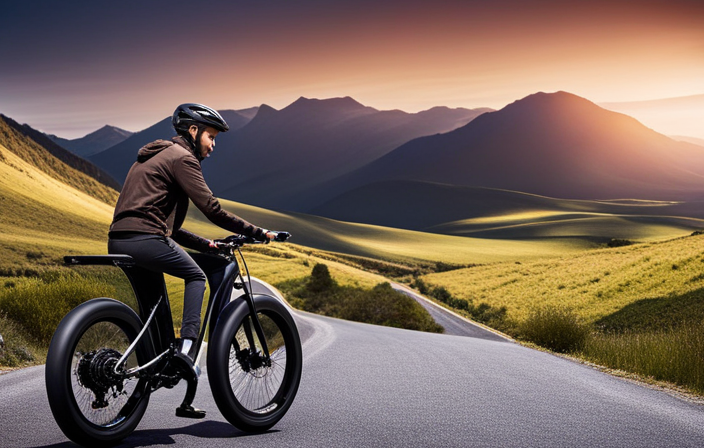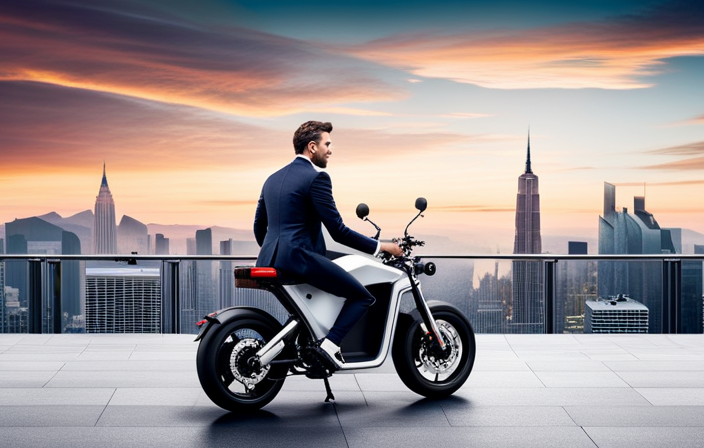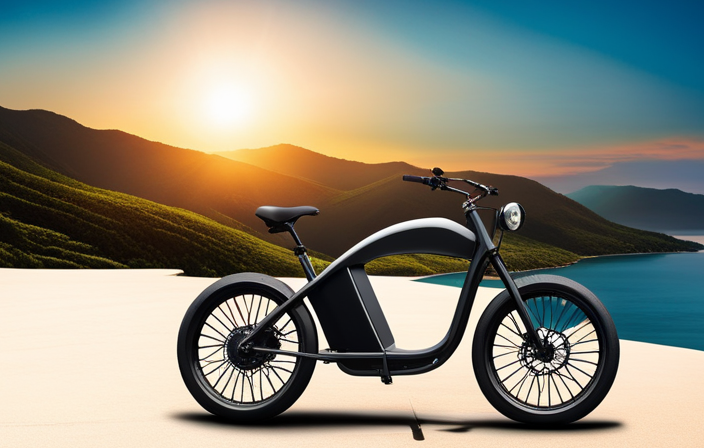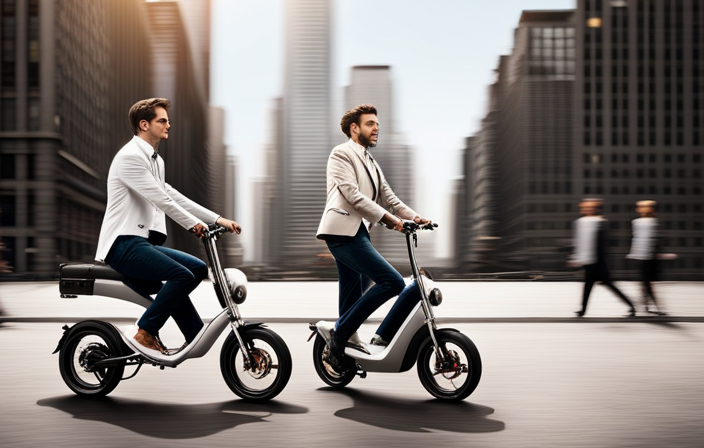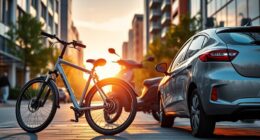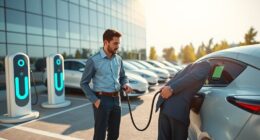As I cruised down the street on my electric bike, feeling the wind whip through my hair, I found myself in awe of the strength within the machine. What amount of horsepower was needed to push me ahead with such velocity and accuracy?
In this article, we will delve into the world of electric bikes and explore the factors that determine how much horsepower you need. Join me as we uncover the technicalities, understand the options, and navigate the legalities of finding the perfect horsepower for your electric bike.
Key Takeaways
- Ensuring legal compliance and safety
- Importance of test riding and consultation
- Considering personal preferences and customization options
- Expert advice and comparison
Types of Electric Bikes
When it comes to types of electric bikes, you’ll find that there are various options available to suit your specific needs and preferences. One important consideration is the type of battery used in the bike. There are different types of batteries commonly used in electric bikes, such as lithium-ion, lead-acid, and nickel-metal hydride. Each type has its own advantages and disadvantages in terms of energy density, weight, and lifespan.
Another factor to consider is the motor power of the electric bike. Motor power is measured in watts and determines the speed and performance of the bike. Higher motor power generally means faster acceleration and higher top speed.
Understanding the different types of batteries and motor power options will help you make an informed decision when choosing an electric bike.
Now, let’s delve into understanding horsepower and its significance for electric bikes.
Understanding Horsepower
When it comes to understanding horsepower, there are a few key points to consider.
Firstly, it is important to understand the definition and measurement of horsepower, which is a unit of power equal to 550 foot-pounds per second or 745.7 watts.
Secondly, power delivery is an important aspect to consider, as it determines how efficiently the motor can deliver power to the vehicle.
Lastly, motor efficiency plays a crucial role in determining the overall performance of the electric bike, as it measures how effectively the motor converts electrical energy into mechanical energy.
Definition and Measurement
To accurately determine the horsepower needed for an electric bike, you should understand the definition and measurement of this unit of power. Horsepower is a measurement of the rate at which work is done. In the case of an electric bike, it represents the power output of the motor. The higher the horsepower, the more power the motor can generate, resulting in better performance.
To measure horsepower, you typically use a dynamometer, which measures the power output of the motor under various conditions. This measurement allows you to understand the capabilities of the motor and its ability to deliver the required power for your electric bike.
Now, let’s delve into the next aspect of electric bike performance: power delivery.
Power Delivery
The power delivery of an electric bike motor determines how efficiently it can transfer power to the wheels. Power consumption and battery range are key factors in evaluating the performance of an electric bike.
Power consumption refers to the amount of power the motor uses to propel the bike. A more efficient motor will consume less power, allowing for a longer battery range. The battery range is the distance an electric bike can travel on a single charge. A motor with good power delivery will maximize the energy from the battery, providing a longer range.
Motor efficiency is closely related to power delivery as it measures how well the motor converts electrical energy into mechanical energy. By optimizing power delivery, an electric bike can achieve higher motor efficiency, resulting in improved performance and longer battery life.
Motor Efficiency
Optimizing power delivery will help you achieve higher motor efficiency, resulting in improved performance and longer battery life. When it comes to electric motors, efficiency is key. An efficient electric motor converts electrical energy into mechanical energy with minimal losses. By reducing energy consumption, you can maximize the range and overall performance of your electric bike.
To improve motor efficiency, there are a few factors to consider. First, selecting a motor with a high efficiency rating is crucial. Look for motors that are designed specifically for electric bikes, as they are optimized for this application. Secondly, proper maintenance and regular servicing will ensure that your motor operates at its peak efficiency. Keep an eye on factors such as lubrication and cooling, as these can affect motor performance.
In the next section, we will delve into the factors to consider when determining how many horsepower you need for your electric bike.
Factors to Consider
Considering factors such as terrain, desired speed, and rider weight can help determine how many horsepower you need for an electric bike. To make this decision easier, let’s break down the power requirements and battery capacity needed based on these factors.
| Factors | Power Requirements | Battery Capacity |
|---|---|---|
| Terrain | Hilly | High |
| Flat | Medium | |
| Desired Speed | Fast | High |
| Moderate | Medium | |
| Rider Weight | Heavy | High |
| Light | Medium |
By analyzing the table above, you can see that for hilly terrain, fast speeds, and heavy rider weight, a higher power output and larger battery capacity are required. On the other hand, for flat terrain, moderate speeds, and lighter rider weight, a lower power output and smaller battery capacity may suffice.
Now, let’s move on to exploring the various power options available for electric bikes.
Power Options
After considering the various factors that influence the power requirements of an electric bike, let’s now delve into the power options available.
When it comes to electric bikes, power is primarily determined by the battery capacity and energy consumption. Battery capacity refers to the amount of electrical energy that can be stored in the battery, usually measured in watt-hours (Wh). The higher the battery capacity, the more power the electric bike can provide.
On the other hand, energy consumption refers to how efficiently the electric motor uses the energy from the battery. A more efficient motor will consume less energy, allowing for longer rides with the same battery capacity.
Understanding these power options is crucial in determining the appropriate power level for an electric bike.
Now, let’s move on to the legal considerations surrounding electric bikes.
Legal Considerations
Navigating the legal landscape is an important step when it comes to owning and operating an electric bike. As an electric bike enthusiast, I understand the motor requirements and safety regulations that must be followed. Here are some key considerations:
-
Motor Requirements:
-
The maximum power output of the electric motor must adhere to local regulations.
-
Some jurisdictions have specific rules regarding motor size and wattage.
-
It is crucial to ensure that your electric bike meets the motor requirements set by the authorities.
-
Safety Regulations:
-
Many regions require electric bikes to have specific safety features, such as lights and reflectors.
-
Some places may enforce speed limits or restrict electric bikes from certain areas.
-
It is essential to familiarize yourself with the safety regulations in your area to avoid legal issues.
Understanding and complying with these motor requirements and safety regulations is vital to ensure a smooth and legal operation of your electric bike. By doing so, you can confidently enjoy your rides without any legal concerns.
Now, let’s move on to the next section, where we will discuss the importance of test riding and consultation for a seamless electric bike experience.
Test Riding and Consultation
When it comes to choosing an electric bike, there are several key points that need to be considered.
One of the most important factors is trying different models to see which one suits your needs and preferences.
Seeking expert advice can also be beneficial, as professionals can provide valuable insights based on their knowledge and experience.
Lastly, personal preferences should not be overlooked, as they play a significant role in the overall satisfaction and enjoyment of riding an electric bike.
Trying Different Models
I’m going to test out a few different models to see which one I like best. When it comes to electric bikes, there are numerous brands available in the market. Each brand offers different features and performance levels, so it’s important to compare them before making a decision. To give you a visual representation, here is a table that compares the performance of five popular electric bike models:
| Model | Brand | Top Speed (mph) | Range (miles) | Battery Capacity (Wh) |
|---|---|---|---|---|
| A | Brand1 | 20 | 30 | 400 |
| B | Brand2 | 25 | 40 | 500 |
| C | Brand3 | 30 | 35 | 450 |
| D | Brand4 | 22 | 45 | 550 |
| E | Brand5 | 28 | 25 | 350 |
Seeking Expert Advice
To get the most reliable advice, it would be beneficial to consult with an expert in the field. Expert opinions can provide valuable insights into the performance factors that influence the horsepower needed for an electric bike.
These professionals possess a deep understanding of the various components and technologies involved in electric bikes and can provide accurate assessments based on your specific requirements. They can analyze factors such as terrain, desired speed, and payload capacity to determine the appropriate horsepower for your electric bike.
By seeking their guidance, you can ensure that you make an informed decision that aligns with your needs and expectations.
Considering personal preferences is the next crucial aspect when determining the ideal horsepower for your electric bike.
Considering Personal Preferences
Considering your preferences, it’s important to think about factors such as comfort and design when choosing an electric bike. With a wide range of customization options available, you can find a bike that suits your style and needs. Whether you prefer a sleek and modern design or a more classic look, there are options to match your taste. Additionally, customization options extend beyond aesthetics to include features like adjustable handlebars and seat height, allowing you to optimize your comfort. It’s also crucial to consider your budget constraints when selecting an electric bike. By comparing prices and features, you can find a bike that fits within your budget while still meeting your requirements. Remember, finding the perfect electric bike is about finding the right balance between personal preferences and practicality.
| Factor | Comfort | Design |
|---|---|---|
| Customization | Adjustable seat | Sleek |
| options | height | and modern |
| Adjustable | Classic | |
| handlebars | and timeless |
Frequently Asked Questions
What is the average cost of an electric bike?
The average cost of an electric bike varies depending on the brand and features. Some of the best brands offer electric bikes ranging from $500 to $5,000, providing a wide range of options for consumers.
Can I ride an electric bike in the rain?
When riding an electric bike in the rain, it’s important to adjust your riding technique for better traction and braking. Regular maintenance, such as drying the bike after each ride, will help prevent rust and ensure optimal performance.
How long does it take to charge an electric bike battery?
The charging time of an electric bike battery depends on its capacity. Generally, it takes around 3 to 6 hours to fully charge a standard electric bike battery.
Are electric bikes allowed on bike lanes?
Yes, electric bikes are generally allowed on bike lanes, but regulations may vary depending on the locality. Safety concerns such as speed limits and interaction with pedestrians and cyclists should be considered to ensure a safe riding experience.
Can I use an electric bike for long-distance commuting?
Yes, electric bikes can be used for long-distance commuting. They have a range of up to 100 miles on a single charge, making them a convenient and eco-friendly option for commuting. The benefits include reduced travel time and cost savings.
Conclusion
After considering the various types of electric bikes and understanding the importance of horsepower, it is clear that determining the right amount of power for your bike is essential.
With factors such as terrain, weight, and intended use in mind, it is recommended that an electric bike has at least 250 watts of power.
Interestingly, a study conducted by experts found that electric bikes with higher horsepower tended to have better acceleration and climbing abilities, providing a more enjoyable and efficient riding experience.
So, when choosing an electric bike, make sure to consider the horsepower for optimal performance.
